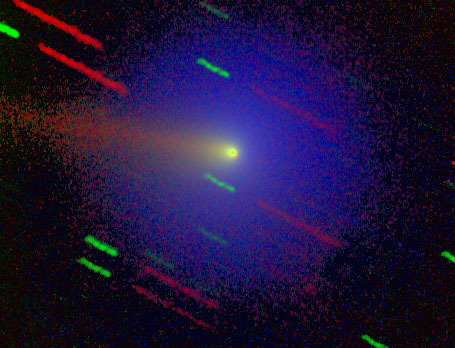

Comet 46P/Wirtanen
| Date: | 11.3.1997
| Time: | 16:42 UT
| Exposure: | 30m, 10m, 30m
|
| Field of View: | 6.2' x 4.7'
| Receiver: | 5122 + (576x387) CCD
| Filter: | IF 614, RX, IF 390
|
| Instrument: |
D=2m, f=5.6m
| Observatory: |
Pik Terskol, Caucasus
| Observer: | T. Credner, K. Jockers, T. Bonev
|
© Copyright by the observers

Max-Planck-Institut für Aeronomie
This comet was selected as target for ESA's Rosetta mission.
The spacecraft was launched in March 2004, however, after postponement of the
initial launch the final destiny did change to Comet 67 P/Churyumov- Gerasimenko.
It will be the very first landing on a cometary nuclei to make in situ
measurements of the surface.
To characterize the comet and set constraints on the spacecraft and experiment
design, observations were carried out at Pik Terskol Observatory.
From Colors to Astrophysics:
We observed the cometary H2O+, dust, and neutral CN gas
with the filters IF 614, RX, and IF 390. In the above image they are represented
in red, green, and blue, respectively.
For the first time Wirtanens ion tail
(here H2O+) could be shown, visible as straight
red diffuse band to the left side (anti-sunward direction). The blue
sphere is the very extended neutral CN Coma. In contrast to this, the dust is much
more concentrated and dominates the near nucleus region, here seen as yellowish green
color. So one result, illustrated with this
representative three color image,
is that 46P/Wirtanen is dust poor and about 2-3 times less dusty than Comet Halley
(T. Credner).
More informations can be found on the special project page of the
 Max-Planck-Institut für Aeronomie.
Max-Planck-Institut für Aeronomie.
Article 1998A&A...335L..56J
This image is also available at:
Comet Observation Home Page by
Charles S. Morris JPL
Rosetta Mission System Design Review 1998 by
DaimlerChrysler Aerospace, Dornier
ESA's Rosetta Gallery
ALICE Home Page
NEO web site

![]()